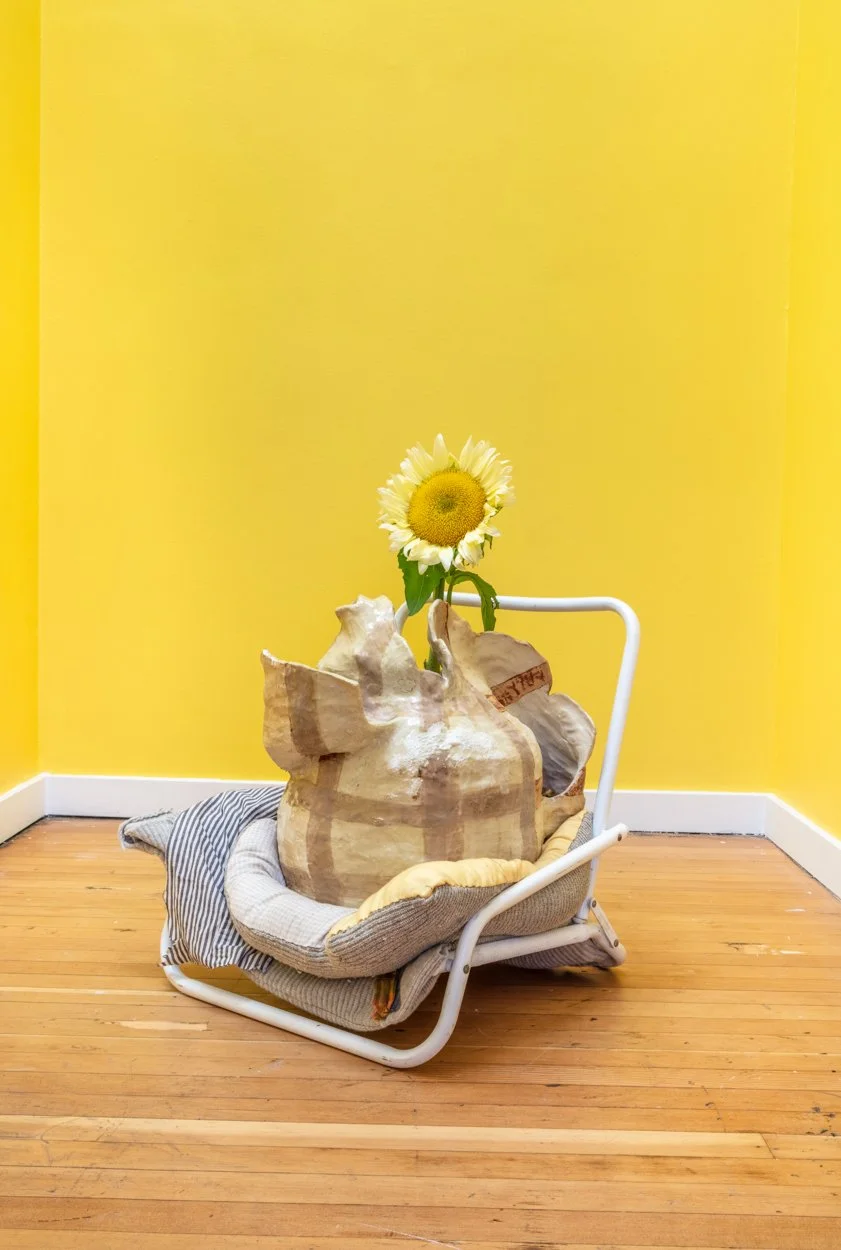Show Press
Shœings
by kalaija mallery
What is the opposite of a shadow made of light? A part of something.
The definition of practice is an intentional return. Encapsulation, reconciliation. A hazelnut. A rock.
The three artists exhibited in Shœings present process-based practices as an intuitive, intrinsic way of making, perhaps working in contradiction to the more logical contemporary receptions of art that privilege qualitative research, objective fact, a more masculine tradition of knowledge-creation. Such stunning corporeal deviation is rooted in antithetical chaos and devotion. It is not to be tamed, it cannot be taught.
Kelsey Hamilton Davis cites her ceramic practice as automatic and auto-theoretical, using Nature as an intentionally vague term to counter a “New England Civility” that connotes her upbringing. She extends her process in and within the natural world as a means of untangling the unanswerable and unsolvable reckonings of inherited colonial archetypes, while leaving room still for magic, for pleasure, and for these contradictions to exist simultaneously. Her work occupies several states: of her studio, of the gallery, of the home. In such a manner, her sculptures may travel and traverse tradition with almost a mind of their own. The works were made for this exhibition while on residence at Guldagergaard International Ceramic Research Center in Denmark.
…
In practice, these three contemporaries join what I understand to be a movement of New Transcendentalists: artists who create to connect to something higher than material – the ineffable. The resulting works may simply become artifacts of such processes and perhaps are imbued with the trace of this energy, or may become rendered entirely inanimate. The process of creation in and of itself echoes and demonstrates that of sound waves, of seances, of rare moments of unitive consciousness, where we may have fleeting moments of recognition of the Great Design, and see that “it is good.”
“Then he showed me a small thing, the size of a hazelnut, nestled in the palm of my hand. It was round as a ball. I looked at it with the eyes of my understanding and thought What can this be? And the answer came to me: It is all that is created. I was amazed that it could continue to exist. It seemed to me to be so little that it was on the verge of dissolving into nothingness.”
Julian of Norwich, 14th cent.
The Showings
Review of some rights from a spring reckoning
by lindsay costello
published by Oregon Arts watch
“When I think of ritual, I think of Joan Didion’s travel packing list. Typed neatly on a twice-folded sheet of paper, one can tell it’s been referenced countless times throughout her life. Nightgown, she lists. Typewriter. Cigarettes. I look at it and marvel—how fascinating—but that intensity of feeling derives from the list’s utter normalcy. Even Joan carries deodorant, house keys; she even has to write it down to remember! Sometimes the most interesting rituals are the banal ones. Many of us have learned that over the past year, taking our walks and noticing the little unspoken happenings of the neighborhood.
…
Kelsey Hamilton Davis’s In the House of Weird Sisters begins with an overture. Installed outside the gallery, a chunky ceramic sculpture oozing pink glaze holds a sharp bouquet of dead thistle. Next to it, Wishing Well Spell Jar, Hamilton Davis’s collaborative project with Kalaija Mallery, further sets the tone for the show. The written piece describes a “spell for a bird girl, from a decoy”; one performs the wish-spell with a jar, a penny, a lavender sprig, blue wax, and a yellow paper star. The piece speaks to Hamilton Davis’s interest in witchcraft and witch aesthetics, but it also reveals something more elusive—a sense of endearing hope, wonderment, and the ache of childhood memory. These themes combine in her thesis installations of ceramics, decoy ducks, textiles, and found objects.
Hamilton Davis’s show is perhaps the most conceptually balanced; it’s backed by both robust research and a delicate personal sensibility. A lush tableau of fruit, ducks, candles, ceramics, and flowers are arranged on pallets; the installation reads like a celebratory altar. Her lengthy titles (ex. Hand-Stitched Tapestry with Her Pajamas, Her Own Bedding from Ikea, and Fabric That She Got In Argentina at The Marketplace Selling Textiles, Mostly from China, But Which Reminded Her of New England) tell stories, but also add humor. Her collection of decoy ducks does, too.
In her thesis talk, Hamilton Davis mentions some reference points for her work: cottagecore, contemporary witch aesthetics, the slippery notion of “slow living,” Greta Gerwig’s Little Women, trios of witches (a trope that stretches from Hocus Pocus all the way back to Macbeth). These nods to pop culture are smart symbols of our preoccupations with pre-capitalist ways of life and casting women as Other. Despite her interests in ritual, spellmaking, and the history of feminine spirituality, Hamilton Davis doesn’t quite land anywhere primordial or Goddess-like in her show. The effect is closer to exploring an estate sale at the home of a mysterious elderly woman, in the best way. It’s human.”

